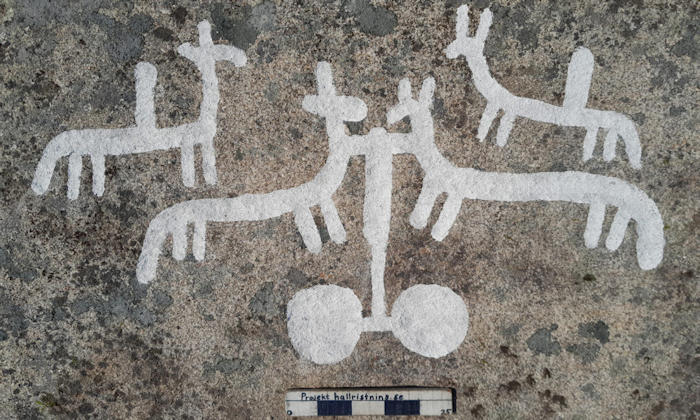STOCKHOLM – The Scandinavian countries have the largest concentration of Bronze Age art on the entire European continent with over 30,000 detected featuring distinctive carved or drawn images of human and animal figures, images of ships, chariots, and other human inventions as well as numerous abstract shapes. This week, a team of archeologists and researchers from the Foundation for Documentation of Bohuslän Rock Carvings announced the number of known images had grown.
The team was astonished to find approximately 40 new petroglyphs carved into a rocky hillside while exploring the countryside near Tanum in Bohuslän, Sweden. The unexpected find was found on a very steep hillside covered by a thick layer of moss that had kept the petroglyphs hidden from view.
The Foundation for Documentation of Bohuslän Rock Carvings exists to “promote the coordination of rock image documentation in Bohuslän in close cooperation with the responsible authorities and institutions.” The Foundation issues continuous field reports about the area and explains that Bohuslän’s rock carvings are one of the world’s strangest pictorial depictions that have survived to the modern day and their continuous work to document and interpret the images expands our understanding of the region and the culture that created them. But this month’s reporting was a major announcement.

Petroglyphs became visible after moss was removed by archeologists. via Courtesy: Foundation for Documentation of Bohuslän’s Rock Carvings
The area of the find is rich in petroglyphs. The Rock Carvings around Tanum are a collection of petroglyphs near Tanumshede, Bohuslän, Sweden, which were declared a World Heritage Site by UNESCO in 1994 because of their high concentration. They appear to date between 1800 to 500 BCE. UNESCO notes that the “Northern Bohuslän is a land of granite bedrock, parts of which were scraped clean about 14,000 years ago as the Scandinavian Ice Sheet slowly moved northward, leaving gently curved rock faces exposed. These were the “canvases” selected by Bronze Age artists. There are at least 1,500 known rock carving sites in northern Bohuslän concentrated in certain areas…. The carvings were executed by pecking and grinding the rock using stone hammers and points.” The art has been described as showing a “rich diversity of compositions “ skillfully executed with simple tools.
The artists varied in their selection of topics to render into the rock. The images range from agriculture and husbandry motifs, hunting and fishing along with carts, ships, and weapons as well as what appear to be images of cultic and/or religious significance. They also likely served as source material for their cultural history and social status and organization.
UNESCO says that “compared to other similar contexts, these motifs and scenes are even more outstanding in their ability to convey reflections of life and cosmology during the Nordic Bronze Age (c. 1700 BC – 500 BC). It is obvious that the intention of these panels, which are often situated in commanding positions in the landscape, is to convey messages, thereby confirming their role as primary contemporary centers for worship and cult.”
In total, there are several thousand images composing the Tanum petroglyphs with about 600 panels contained within the World Heritage Area. The petroglyphs are concentrated along a 15-mile (~25 km) stretch of the northwestern Swedish coastline near its border with Norway and cover an area of about 126 acres (51 hectares or 0.5 km²). The petroglyphs were made by Scandinavian Bronze Age and Iron Age people who were sophisticated craftsmen and competent seafarers.
One of the consistent images across the Tanum region is the depiction of boats, particularly a Hjortspring-like boat, a canoe-like vessel that carried about 20 people. The region was coastal when the drawings were made, and the newly found images too would have likely been near the edge of the water. It is now about 80ft (~25m) above sea level.

Petroglyphs on rock via Courtesy: Foundation for Documentation of Bohuslän’s Rock Carvings
The new find was made by a keen-eyed team of archeologists who noticed a white image under the moss layer, said the Foundation. When the researchers scraped away at the moss, that image turned out to be a boat carved into the stone’s surface. The carving’s out layer had weathered to a dull gray in color likely from cyanobacteria at the carvings’ original seaside location. The archeologists, however, soon exposed a chalky white underlayer revealing the full image of the long boat.
The large section of rock featuring the petroglyphs is approximately 50 feet (15 meters) long and includes some unusually large carved-out figures, including a ship that is almost six feet (two meters) long and a stylized human figure measuring approximately three feet (one meter) tall.

via Courtesy: Foundation for Documentation of Bohuslän’s Rock Carvings
“These are very large things, including a two-meter ship and a person over one meter in height. The figures are well-carved and deep. The motifs are not unique, but the location on an almost vertical outcrop is unusual”, says archaeologist Andreas Toreld.
He added that the petroglyphs are huge. “The motifs are not unique, but the location on an almost vertical outcrop is unusual.” Toreld hypothesized that the artists were likely on a boat while doing their work.
Toreld said that “During the Younger Bronze Age, from which this one comes, the style was closest to Baroque. Everything was bloated and exaggerated, but perhaps not so realistic.”
The finding itself is extraordinary but it highlights that many more such petroglyphs are hiding in the countryside.
The Wild Hunt is not responsible for links to external content.
To join a conversation on this post:
Visit our The Wild Hunt subreddit! Point your favorite browser to https://www.reddit.com/r/The_Wild_Hunt_News/, then click “JOIN”. Make sure to click the bell, too, to be notified of new articles posted to our subreddit.
